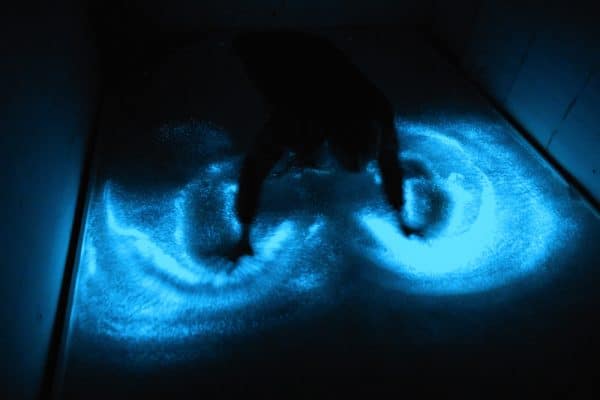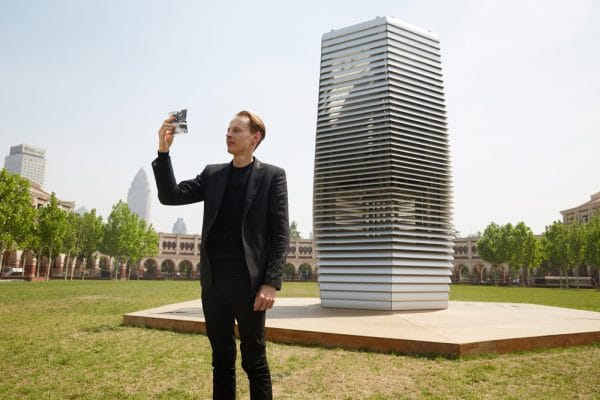“When we look at our cities, they have become machines that are killing us,” exclaims Daan Roosegaarde, designer, architect, inventor and creative visionary. “I’m out there hunting ideas, focusing on all the things that don’t exist yet to make it better.”
Tracking the scent of new ideas, innovations and ways of seeing the world, this 21st century Renaissance man brings his raw ideas back to his glass-fronted studio in Rotterdam, Netherlands – a place dubbed “the Dream Factory”. It’s here that a 16-strong team sets out to germinate Roosegarde’s thoughts into imaginative innovations that tackle some of the modern world’s most pressing environmental issues, in the most awe-inspiring of ways.
From kites that generate electricity, to smog-free towers that pull pollution from the air; bike pathways lit up by the same material as the glowing stars stuck to your childhood bedroom ceiling, to large-scale visual installations using light and water vapour to create virtual floods that highlight what water levels would do without human intervention – these creations, inventions and wonder-inducing installations take years to perfect, yet seem beautiful in their simplicity.
And each of them begins from a single moment, the instance Roosegarde dared to ask the question, “Why?”
“My ideas come from an irritation with why the world is the way it is.”
Ask, then do
“It’s not about inspiration, but frustration,” Roosegarde explains. “My ideas come from an irritation with why the world is the way it is. Suddenly I get mesmerized and captivated by it. Then I do something to change it.”
And changing things for the better is certainly what this gamechanger has set out to do. Drawing on his talents to look deeper at the world around him, following his curiosity to ask questions about a modern reality most of us have become blind to, Studio Roosegaarde represents what our imagination is capable of – a state of being that refuses to be passive. “For me, innovation is realizing that maybe everything already exists. But we need to create new connections, new links. When it comes to innovation, there’s not a lack of money or lack of technology, but perhaps a lack of imagination, or collective imagination.”
“Anthills don't have traffic jams. So why do we?”
Bonding the Break

With this ‘dream it, do it’ attitude, Roosegarde’s work is rallying people to stand up, recognize and challenge our modern apathy. It’s an approach that at its heart highlights and reconnects the fractured bond between humans and nature. “Anthills don’t have traffic jams, so why do we? Nature doesn’t waste, so why do we?” he asks. “In nature, beings provide clean air for each other; it’s a symbiotic relationship. Let’s learn from these amazing principles.”
Whether it’s their current obsession with light-emitting algae plankton – so pure you can drink it – or covering buildings in micro-pearls to act as urban lights, Studio Roosegaarde has a desire to jolt us from our digital reveries, and marry us all back to the physical world. “We live in a world where we’re feeding our hopes and dreams and desires to the cloud, Google, Twitter, Webo,” he says. “Our physical world is sort of crashing, with rising sea levels and pollution. I’m very interested in connecting the two worlds more with each other. By showing people the beauty of a potential new world, it activates them to participate in the solution.”
All together now

Harnessing people power is the very resource that Roosegarde has drawn on to create one of his most pioneering innovations; the smog-free tower. Born from looking over the muddied skyline of Beijing, he had the idea for a huge smog vacuum cleaner that would be able to suck up polluted city air, clean it and release it back into the atmosphere. But it didn’t stop there. The Studio Roosegaarde team realized that the filtered carbon waste from these smog towers could, with enough pressure applied, be formed into black diamonds. These smog diamonds could be set in jewellery and sold as a concrete symbol of innovation’s impact on the world. Some couples have even used them as engagement rings.
This, however, was one innovation he couldn’t have realised alone. “A lot of mayors around the world were interested in the project. But they were scared that if they were to invest in smog free towers, the inhabitants of their city would know how polluted they were,” Roosegarde explains. “But if you live in downtown Delhi, you probably already know?! So we had a problem.” It was then that the team channelled the power of people to be part of the solution. “We put the project on Kickstarter. And it worked. Using the community we disrupted from bottom up.”
Parallel futures
So where does he see the future taking us? “There’s Orwell’s vision, where we use technology to reduce human activity and lose control. Or we have Da Vinci’s vision, where we use technology to cure and enhance ourselves.” According to Roosegarde, the best way to pursue Da Vinci’s path – which seems altogether more appealing – is to start making the change yourself. “You throw a rock in the river and you create ripples. That’s what I’m doing. And when other people throw rocks as well you get these beautiful patterns and things start to resonate in the water and that’s joy. I’m curious about what happens when the ripples start to collide and make patterns.”
If the innovation rests in the ripples, perhaps we should encourage Dutch designers in glass studios to throw stones, and chuck a few of our own too, for good measure.
+
‘Force of Nature’ first appeared in Kodachrome Issue 3, Kodak’s journal of art, creativity and analogue culture.
Images: Daan Roosegaarde